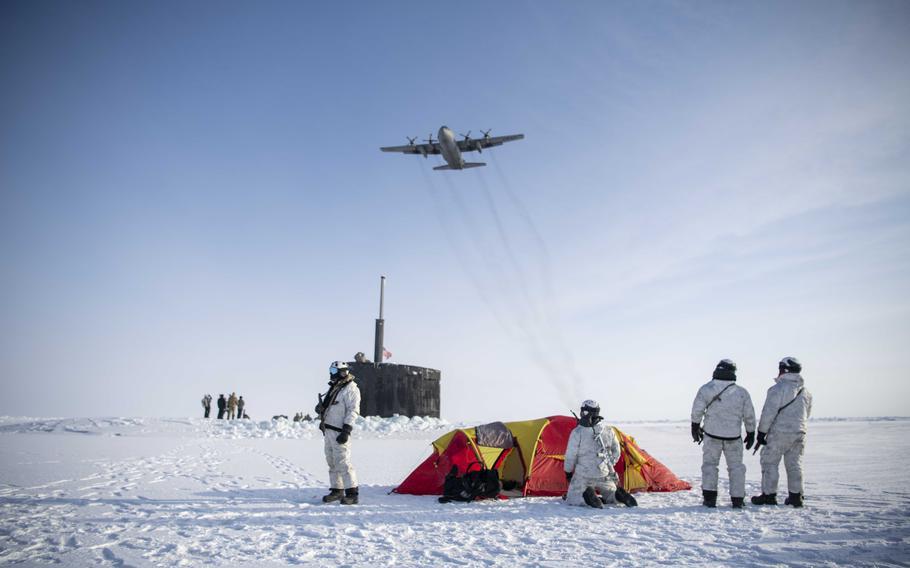
A C-130 Hercules assigned to the 109th Airlift Wing, part of the New York Air National Guard, flies over Navy SEALs, Norwegian naval special operations commandos and the attack submarine USS Hampton during an integration exercise in the Arctic Ocean on March 9, 2024. (Jeff Atherton/U.S. Navy )
WASHINGTON – The Defense Department is working to modernize early warning systems and build a communication network in the Arctic as warmer weather opens more waterways and allows Russia and China to threaten stability in the region.
“Climate change and the resulting shifts in the operating environment require us to rethink how we best protect our warfighters and prevent conflict. This transformation affects how we support our allies and partners, and it impacts our ability to deter and, if needed, defeat our adversaries. And that’s exactly what this new Arctic strategy takes into account,” said Kathleen Hicks, the deputy defense secretary.
The U.S. will take a “monitor and respond” approach by enhancing the Joint Force’s Arctic technology, engaging with allies and partners, including local authorities and Alaskan native tribes, and being more present in the Arctic region, according to the 2024 Arctic Strategy released Monday by the Pentagon.
The 18-page document includes efforts to update long-range early warning systems and tracking sensors and maritime surveillance systems for the North American Aerospace Defense Command, as well as conduct independent and joint military operations in the region.
The strategy comes as the Arctic warms three times faster than the rest of the planet. The Arctic could experience its first practically ice-free summer by 2030, according to the Defense Department. Melting sea ice opens the possibility of new shipping lanes and greater access to undersea natural resources that Russia has been looking to exploit.
Russia, the largest of the eight Arctic nations, has built up military infrastructure in the region and has a clear route to the U.S. through the Arctic. Russia’s Arctic access, the document reads, could be used to constrain the ability of the United States to respond to crises in Europe and the Indo-Pacific regions.
Additionally, China declared itself a “near-Arctic state” in 2018, signaling interest in the region. Russia and China have been collaborating on development in the Arctic, as well as conducting joint training exercises for years, raising U.S. and NATO concerns.
“We must have a strategy that ensures our military readiness in the face of these changes, ensuring our ability to quickly respond to threats in the region and to the overall demands they place on our force,” Hicks said.
The 2024 strategy, she said, works to that end.
Iris Ferguson, the deputy assistant secretary for Arctic & Global Resilience, described the strategy as being “action oriented,” which she said distinguishes it from prior Arctic strategies.
“We unpack where we need to sustain our investments, especially in critical capabilities. What do we have to see? How do we communicate? Do we have the right equipment to operate in the region? My office exists to champion these capabilities, which are vital to the successful implementation of our strategy,” Ferguson said.
To better monitor the High North, the Defense Department will modernize its long-range aerospace and maritime surveillance systems. The Pentagon is also researching options for new space-based missile-warning and observational systems and assessing ways to improve ground-based sensors to complement existing NORAD capabilities. Hicks estimated the Defense Department had invested $43 million in ground-based sensors in recent years.
A lack of satellite coverage in the Arctic has challenged the establishment of communications that would facilitate tactical and strategic communications, the strategy reads. To combat this, the Pentagon has contracted Starlink, SpaceX and OneWeb to provide services for satellite communications terminals. Connecting terminals to satellite constellations will be tested in the summer of 2025, Ferguson said.
The Defense Department is also investing in cold weather equipment and mobility for Arctic-based troops living and working in the austere environment.
Hicks said the Pentagon is unable to quantify how much is being invested in implementing the Arctic strategy because it does not budget by region. But Ferguson highlighted some of the funding and where it is going:
• $7 million dedicated to Pituffik Space Force Base, Greenland, to mitigate permafrost.
• $280 million on all-terrain vehicles and cold weather gear for the 11th Airborne Division in Alaska.
• $1.8 billion from the Space Force for a high-frequency military satellite communications system designed to provide 24/7 secure, anti-jam communications for U.S. forces operating in the Arctic.
The strategy also outlines training and operations in the region and a growing partnership between the U.S., Canada and Finland to procure three U.S. Coast Guard ice breakers.
“Should the security environment shift in a way that necessitates a DoD response, DoD will remain able to deploy the joint force globally at the time and place of our choosing. This includes responding in the Arctic, both independently and in cooperation with allies and partners,” the strategy reads.
The Defense Department last updated its strategy for the Arctic in 2019, with the first one published in 2013. More than a decade later, Ferguson said the current strategy reflects a “greater awakening” across the Defense Department as enemy capabilities and technology have advanced.
“We can’t just show up to operate there,” she said. “We have got to exercise proficiency. We have got to make sure that we are working with our partners and actually exercising with one another so that we survive when we are there.”